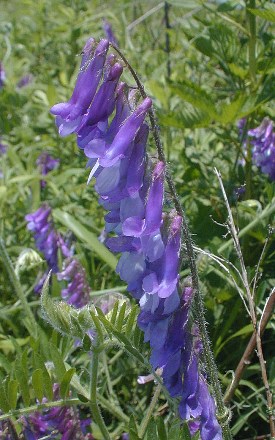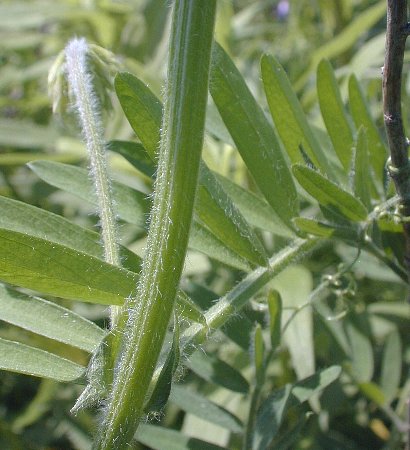Description:
This
annual or biennial plant is 1-3' tall, branching
occasionally and having a tendency to sprawl. The round stems have
spreading white hairs and conspicuous ridges. The alternate compound
leaves are up to 10" long and 2" across, consisting of 8-12 pairs of
leaflets and a terminal tendril that clings to adjacent vegetation for
support. The central stalk of each compound leaf has spreading white
hairs. The leaflets are up to 1" long and ¼" across. They are oblong, oblong-lanceolate, or linear, and have smooth margins with small
pointed tips. There are usually scattered white hairs across the lower
or upper surface
of the leaflets. Slender racemes of
flowers up to 6" long develop from the axils of the compound leaves.
The stalks of these racemes are covered with spreading hairs and often
turn purple toward their tips. The one-sided racemes consist of 5-20
pairs of nodding flowers. These flowers vary in color from pink to
blue-violet, depending on the strain or local ecotype. Each tubular
flower is about ½–¾" long, consisting of 5 petals and a hairy calyx
that is united at the base. Aside from its long tubular base, the
flower has a typical pea-like structure, consisting of a standard,
keel, and 2 side petals. The upper petal forming the standard is
usually a darker shade of color than the remaining petals. The tubular
calyx varies in color from green to purple and has hairy teeth. The
lower teeth of the calyx are much longer than the upper teeth. The
swollen base of the calyx protrudes behind the apex of the pedicel,
rather than originating directly from it. The blooming period usually
occurs from early to mid-summer and lasts about 1-2 months, although
some plants may bloom later in the year. Each flower can produce a
flat-sided seedpod that is up to 2" long and contains several round
seeds. The root system produces rhizomes, enabling this plant to form
vegetative colonies.
oblong-lanceolate, or linear, and have smooth margins with small
pointed tips. There are usually scattered white hairs across the lower
or upper surface
of the leaflets. Slender racemes of
flowers up to 6" long develop from the axils of the compound leaves.
The stalks of these racemes are covered with spreading hairs and often
turn purple toward their tips. The one-sided racemes consist of 5-20
pairs of nodding flowers. These flowers vary in color from pink to
blue-violet, depending on the strain or local ecotype. Each tubular
flower is about ½–¾" long, consisting of 5 petals and a hairy calyx
that is united at the base. Aside from its long tubular base, the
flower has a typical pea-like structure, consisting of a standard,
keel, and 2 side petals. The upper petal forming the standard is
usually a darker shade of color than the remaining petals. The tubular
calyx varies in color from green to purple and has hairy teeth. The
lower teeth of the calyx are much longer than the upper teeth. The
swollen base of the calyx protrudes behind the apex of the pedicel,
rather than originating directly from it. The blooming period usually
occurs from early to mid-summer and lasts about 1-2 months, although
some plants may bloom later in the year. Each flower can produce a
flat-sided seedpod that is up to 2" long and contains several round
seeds. The root system produces rhizomes, enabling this plant to form
vegetative colonies.
Cultivation:
Full or partial sun, moist to mesic conditions, and fertile loamy soil
are preferred, although sometimes this plant is found in drier
locations, such as slopes. It does well in grassy areas, because the
blades of grass provide support for the tendrils while admitting
sufficient sunlight for the leaves. Like many other introduced vetches,
Hairy Vetch can spread aggressively.
Range & Habitat:
This is a common plant in many areas of central and northern Illinois,
but it is less common in southern Illinois (see Distribution
Map). Official records probably underestimate its actual
occurrence within the state. Hairy Vetch was introduced into the United
States from Europe as a forage crop for livestock. Habitats include
moist to mesic black soil prairies, grassy meadows along rivers or in
woodlands, banks of rivers, shoulders of highway overpasses, areas
along roads, edges of cropland, and abandoned fields. Sometimes this
plant becomes an agricultural pest and invades fields, and it can also
successfully compete against native plants in natural habitats. While
Hairy Vetch forms colonies, they are not dense enough to exclude other
species of plants, unlike the colonies that are formed by Coronilla
varia (Crown Vetch).
Faunal Associations:
The nectar of the flowers attracts long-tongued bees primarily,
especially bumblebees. Less common visitors include butterflies and
skippers. The caterpillars of the some butterflies and moths feed on
vetches and other legumes, including Glaucopsyche lygdamus
(Silvery Blue), Colias eurytheme (Orange Sulfur),
and Caenurgina chloropha (Vetch Looper Moth).
Insects feeding on the seeds or seedpods include Acanthoscelides
spp. (Bean Weevils) and Pitedia persimilis
(Stinkbug sp.), while Epicauta fabricii (Blister
Beetle sp.) feed on the foliage and flowers. There are scattered
reports of upland gamebirds eating the leaves or seeds of vetches to a
limited extent, including the Ruffed Grouse, Wild Turkey, and
Ring-Necked Pheasant. The foliage of Hairy Vetch is palatable and can
be eaten by mammalian herbivores, although there have reports of cattle
being poisoned after feeding from bags that contained seeds of Hairy
Vetch.

Photographic
Location:
A moist black soil prairie remnant along an abandoned railroad in
Champaign County, Illinois.
Comments:
Hairy Vetch has attractive flowers in long racemes, usually in
off-shades of pink or blue. There are several Vicia spp.
(Vetches) that occur in Illinois, although botanists disagree among
themselves over the exact number. For example, several varieties of
Hairy Vetch have been identified, but Mohlenbrock (2002) considers some
of these varieties to be distinct species. Hairy Vetch can be
distinguished from other vetches by the presence of spreading hairs on
its stems, the large number of flowers on its racemes (5-20 pairs), and
the shape of its calyx (lower teeth much longer than the upper teeth; a
swollen base that protrudes behind the pedicel). Some vetches with a
similar appearance to Hairy Vetch include Vicia cracca
(Cow Vetch) and Vicia dasycarpa (Smooth Vetch).
However, Cow Vetch is a perennial plant that has appressed hairs on its
stems and the calyx of its flowers doesn't have a protruding swollen
base. Smooth Vetch is virtually identical to Hairy Vetch, except that
it is largely lacking in hairs of any kind. This latter species is
sometimes considered a variety of Hairy Vetch.